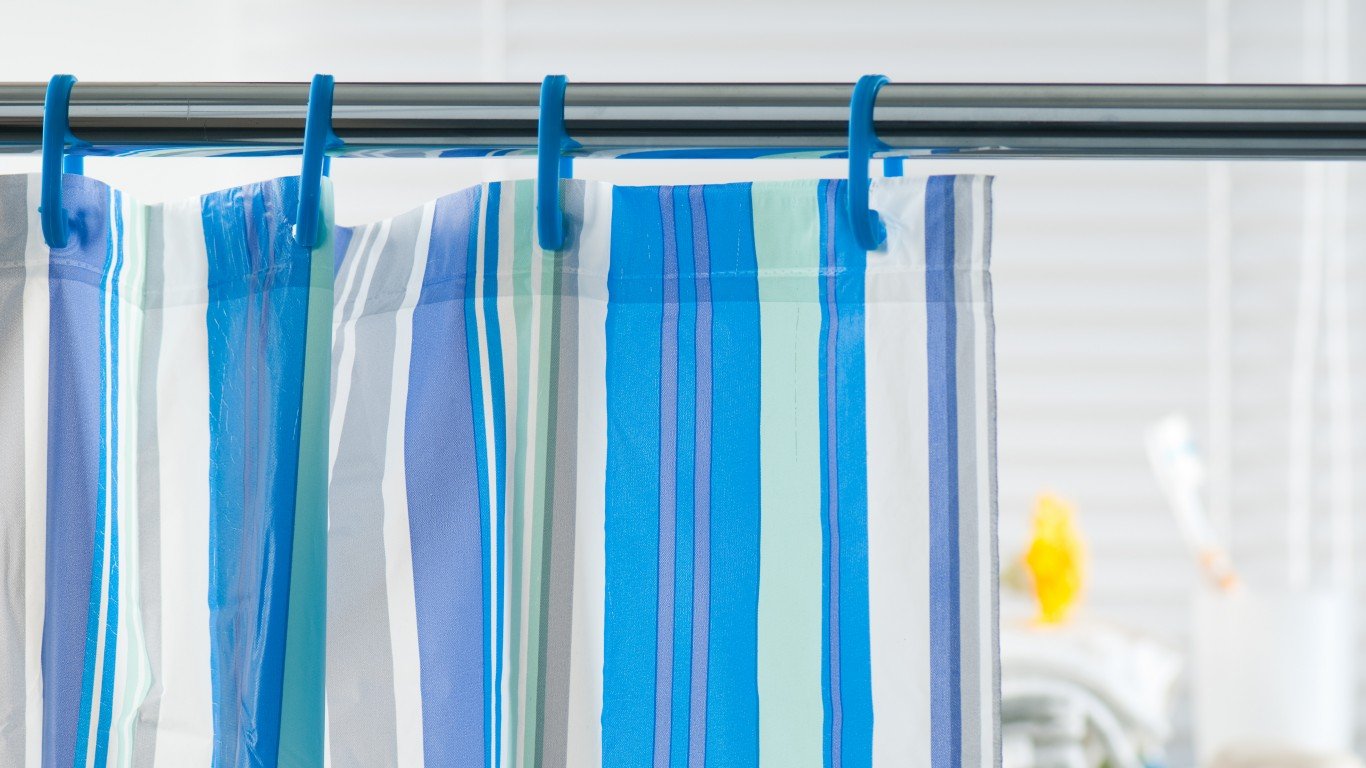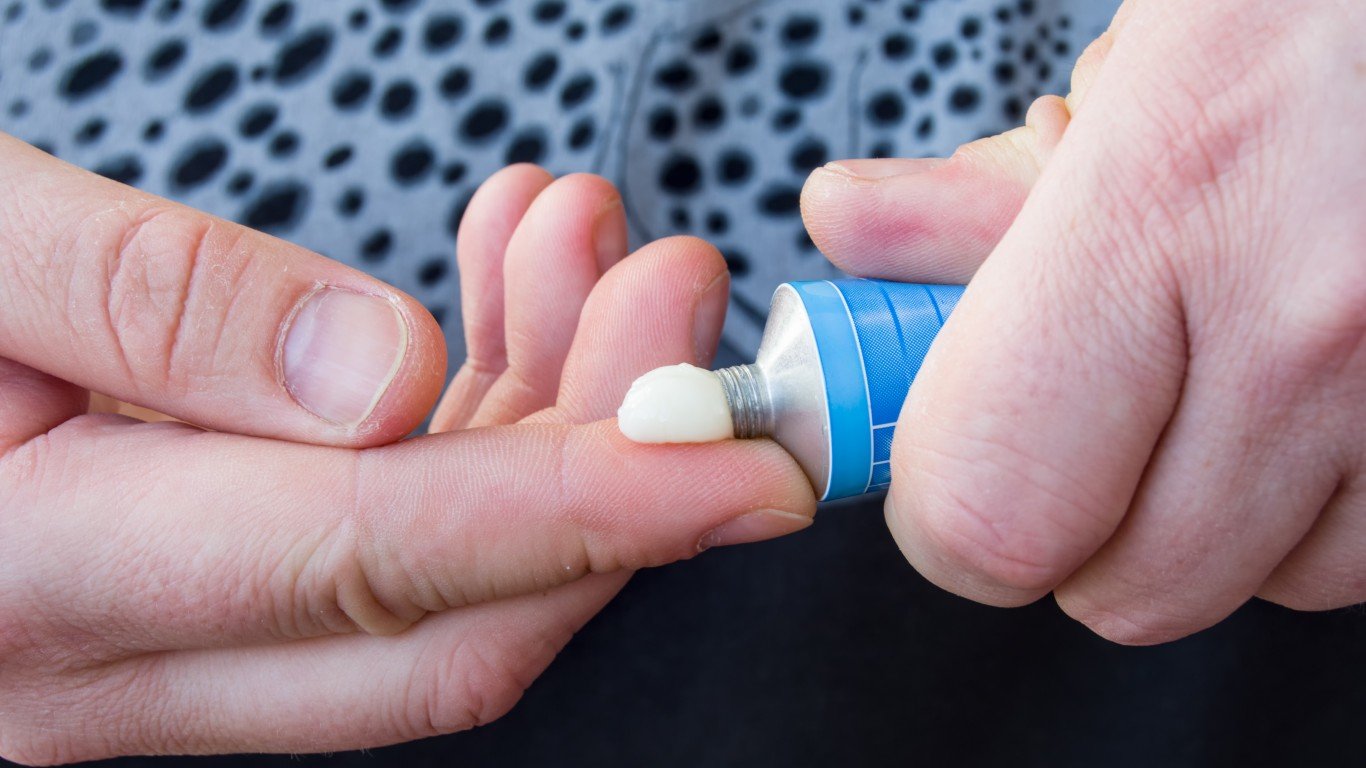Where you live and lay your head should be of hearth and home. Yet, the number of random chemicals sold under innocuous labels means that danger lurks behind every cabinet. We’re not talking just old-school materials like asbestos or lead, either. Be it skin creams, mattresses, or even a non-stick pan, an alarming number of toxic chemicals can be found in common household items. Let’s explore the toxic chemicals that may be living in your house. (Learn about foods that can make you sick or even kill you.)
To compile a list of toxic chemicals found in your home, 24/7 Tempo consulted a range of Government websites and Health Advisory pages including the Environmental Protection Agency, the Center for Disease Control and Prevention, and the National Institute of Health. From there, we picked materials that are found in a wide array of common household items.
Bisphenol-A (BPA)and Bisphenol-S (BPS)

Two common toxic materials in your home are Bisphenol-A (BPA) and its chemical relative, Bisphenol-S (BPS). These organic compounds are used in the production of synthetic fibers and hard plastic. While they are often used as a replacement for BPA in things like paper receipts, these two chemicals are used in loads of other common items. These include the lining of food and beverage cans and medical devices. These chemicals will also show up in household dust.
While BPA is used more and more as a replacement for BPS, neither is very good for you. Both these chemicals are endocrine system disruptors and cause damage to the body overall. BPS has been found to increase the presence of breast cancer carcinogens as well as the spread of positive breast cancer cells. Beyond that, BPS is linked with impaired neural function as well as insulin resistance and irregular vascular function in young children.
Unfortunately, it’s hard to completely avoid either of these chemicals since they are used in many goods. However, you can limit your exposure to BPA and BPS by avoiding paper receipts and hard plastics used in food and storage. It should be noted that even if said plastic is labeled as “BPA-Free,” it will likely contain BPS, which is just as toxic. (Discover the most contaminated foods in the produce aisle this year.)
Formaldehyde

Another commonly used toxic material, often found in your home, is formaldehyde. At room temperature, formaldehyde is a colorless and flammable gas, usually identified by its strong odor. While it’s best known as a preserver of corpses, this toxic chemical is also used in very common goods. These include fertilizers, pesticides, glue, paint, paper products, and composite wood. What’s more, it can be created through combustion reactions in cigarette smoke and fuel-burning machines like gas stoves.
What’s scary about formaldehyde is it’s almost impossible to avoid. Everyone is exposed to trace amounts of the chemical daily. This is due to inhalation after it has been 0ff-gassed from products, especially composite wood. As for its health effects, formaldehyde irritates the skin as well as the ear, nose, and throat. What’s more, high levels of exposure can cause different types of cancer.
Since this chemical is found in many items, exposure is guaranteed. That said, the Environmental Protection Agency (EPA) has taken steps to regulate the level of formaldehyde released from composite wood products. The EPA has also established a program to verify that wood panel producers are limiting the amount of this chemical released from their products.
Perfluorinated chemicals (PFCs)

While perfluorinated chemicals (PFCs) cover an array of similar compounds, almost all are used to make products resistant to heat, grease, oil, and water. As such, PFCs are used in a wide range of household items. These include the insulation of electric wires, non-stick cooking surfaces like pans or grills, as well as clothing and adhesives.
Though the long-term effects of PFCs on the body are not well understood, some studies have shown the chemicals cause injury to the liver as well as effects on growth, development, and reproduction. What’s scary about this toxic chemical family is a couple of them, PFOS and PFOA, do not break down in the environment at all. Trace amounts of these toxins are found in bodies of water and animals.
Unfortunately, the exposure to PFCs and the ensuing health effects are not well known. Scientists are not entirely sure how much of a detrimental effect these chemicals have on people, except they persist in the environment for a long time. To decrease your risk of PFC exposure, it might be best to resort to an old, sticky frying pan. (Discover the seven grocery store items most likely to cause food poisoning.)
DEHP

If you live in California, chances are, you’ve seen the ever-present cancer warnings on goods and buildings. This is mostly due to DEHP, a toxic material found in your home, on the street, or practically anywhere you go. DEHP is a type of phthalate, a chemical used to make certain plastics more flexible. Though usage has certainly decreased in recent years, the chemical is still found in many common goods. These include shower curtains, shoes, lunchboxes or backpacks, and medical devices like IV bags.
As for the effects of DEHP, exposure to the chemical may increase the risk of cancer. It may also affect the reproductive system, especially in men. What’s more, exposure to it during pregnancy can affect the development of the child. For this reason, DEHP is listed on California State Proposition 65. This aforementioned proposition requires businesses to list a warning on their goods and services that may cause cancer.
Since DEHP mostly accumulates in the dust and air, it’s hard to completely avoid. That said, you can limit your exposure to this toxic chemical by regularly washing your hands and cleaning/dusting your home. Plus, if you eat more fresh, unprocessed food, this can limit your exposure as well.
Benzyl benzoate

Another toxic material found in your home is benzyl benzoate. It is an organic compound that serves as both a topical ointment and insect repellent. Benzyl benzoate, however, is most commonly used as a medical treatment for conditions like scabies or lice. Plus, this chemical is also often found in food additives and fragrances. The difference between medicine and poison, however, is the dose.
That’s because benzyl benzoate is a suspected neurotoxin. Its side effects include skin irritation, with overdosing resulting in severe blistering, hives, or rash. How the chemical works on the body is not entirely clear, but it’s not recommended for children. What’s more, it has been shown to be very toxic to cats.
Like other toxic materials on this list, Benzyl benzoate is pretty hard to avoid, especially if you’re prescribed it for a medical condition. Nevertheless, it’s recommended you keep any material featuring benzyl benzoate away from your eyes and nose.
Polybrominated Diphenyl Ethers (PBDEs)

Polybrominated Diphenyl Ethers (PBDEs) are a class of flame-retardant chemicals used to keep items from burning too quickly or catching fire. These chemicals have been used for decades in a wide array of common goods and household items. These include mattresses, televisions, stereos, upholstered furniture, and more.
The problem with PBDEs is they do not break down quickly. They also slowly migrate out of products into the environment, and have been found in everything from soil to people’s fat tissue. What’s worse, PBDEs have been shown to affect the development of babies. Studies have also shown these chemicals to alter hormone levels and disrupt the thyroid in animals.
To prevent exposure to these noxious chemicals there are a few recommendations. For one, you should reduce your exposure to indoor dust by cleaning with a damp cloth. Second, any foam products bought before 2005 are likely to contain PBDEs, so it is best to buy newer mattresses or carpet pads. Finally, if you’re in the market for electronics, request products that don’t contain Deca-BDE or other fire-retardant chemicals. (Learn tips to improve the air quality in your home.)
